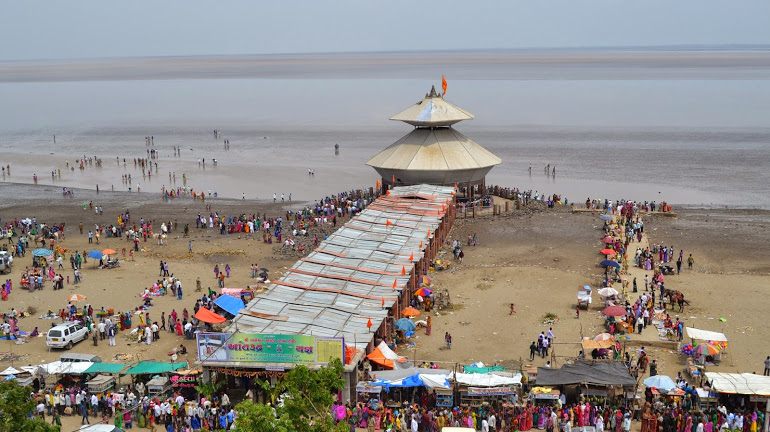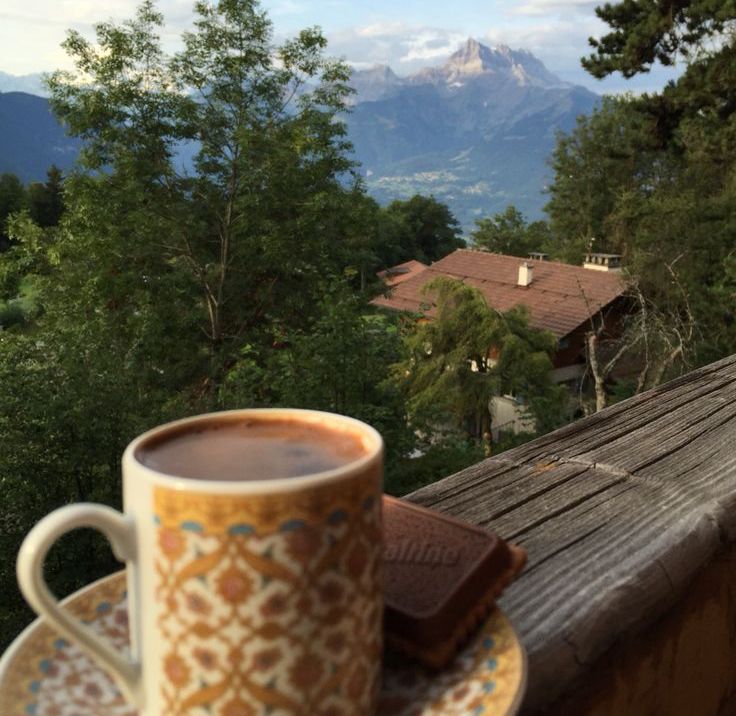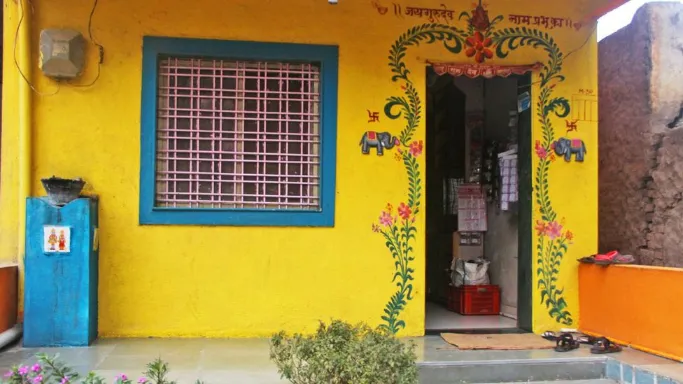Growing up in Vadodara, Gujarat, with my family was a treasure trove of unforgettable experiences. We spent countless days exploring nearby places, creating memories that I hold dear to this day. The joy of visiting ancient temples, savouring the local delicacies like Farsan and Dabeli, and celebrating Navratri with unmatched fervour are moments etched in my heart. But perhaps the most cherished memories were those carefree days spent playing hide and seek with my cousins and the neighbourhood kids, our laughter echoing through the corridors of our childhood.
Fast forward to today: a reunion with my cousins in Ahmedabad reignited a desire to revisit Vadodara and relive those golden memories. We booked a Savaari cab from Ahmedabad to Vadodara, embarking on a road trip that felt like stepping back in time. As we journeyed, soaking in the scenic beauty and reminiscing about our childhood games, our Savaari chauffeur, who had been quietly listening, shared an intriguing tidbit. He told us about a nearby temple that seemingly plays hide and seek. We were stunned! Could a structure actually move and hide? He explained that this temple mysteriously disappears and reappears twice a day. We were baffled. How could such a thing be possible? It sounded too wild to be true, but our curiosity got the better of us. So, we hopped back in the cab, eager to witness this mystical marvel.
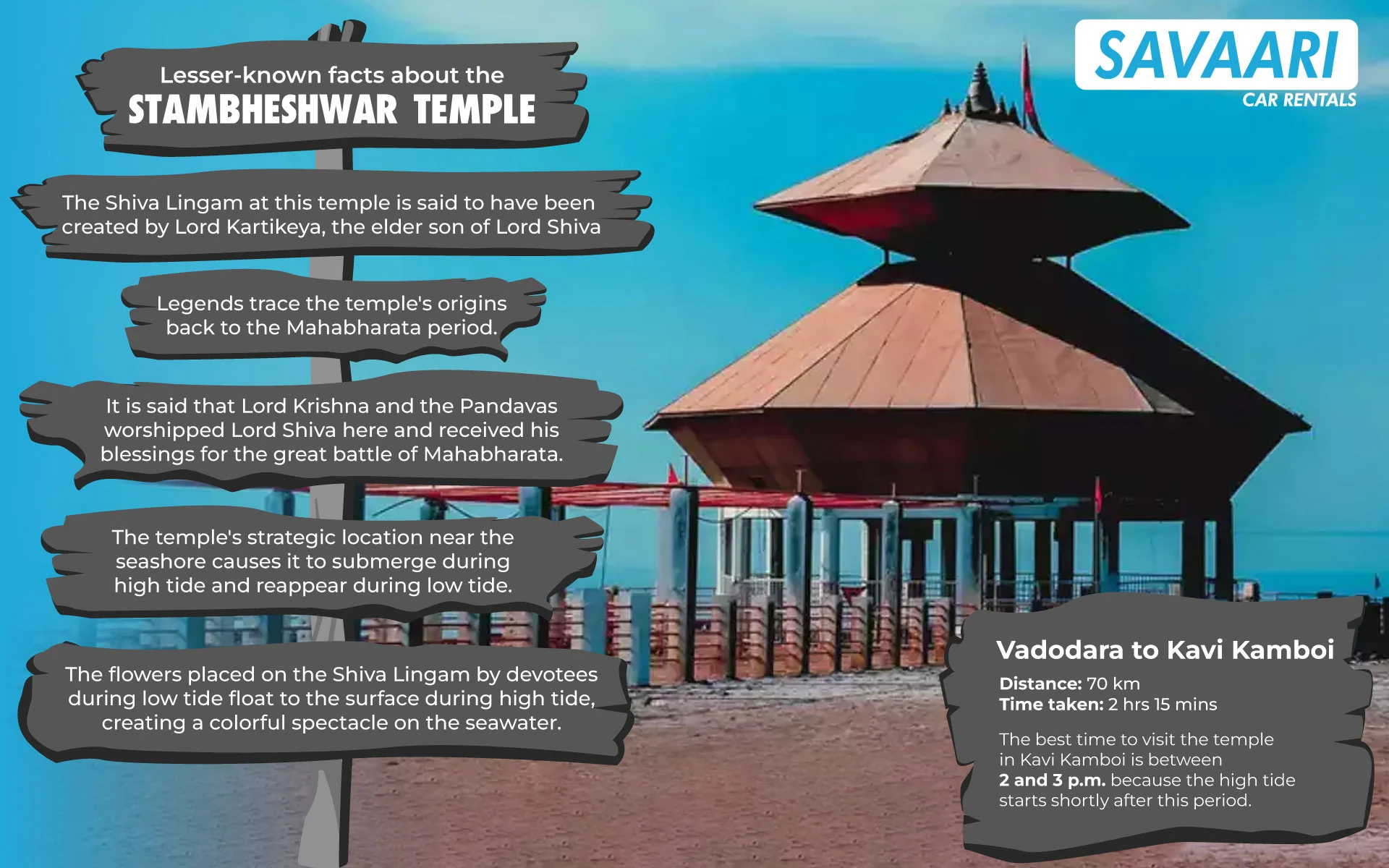
A road trip to the mysterious disappearing temple
As we embarked on our journey to the disappearing temple, the landscape began to transform dramatically. The vibrant cityscape gave way to sprawling fields and rustic villages, painting a picturesque scene as we made our way towards Kavi Kamboi. The temple was approximately 70 kilometers from Vadodara, and we eagerly anticipated the adventure that awaited us.
The route was nothing short of scenic, offering a blend of nature’s beauty and rural charm. Lush green fields stretched out on either side of the road, dotted with patches of wildflowers that added bursts of color to the landscape. Occasionally, we passed by quaint villages where children waved at us, and elders sat under shady trees, exchanging stories and laughter. The roads were well-maintained, ensuring a smooth and comfortable ride.
Our chauffeur skillfully navigated the winding paths, sharing anecdotes about the local culture and the mysterious temple we were headed towards. As we got closer to our destination, the anticipation grew. The scenery became even more captivating with glimpses of the sea in the distance, hinting at the coastal charm of Kavi Kamboi. We found ourselves immersed in the journey, soaking in every moment as we drew nearer to the mysterious disappearing temple, our excitement mounting with every passing kilometer.
Stambheshwar Mahadev Temple in Kavi Kamboi – The disappearing temple of India
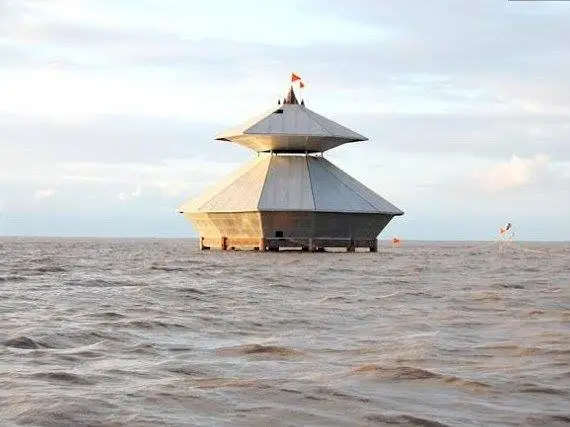
Upon our arrival, our chauffeur shared intriguing details about the Stambheshwar Mahadev Temple in Kavi Kamboi, a 150-year-old shrine and one of the oldest temples dedicated to Lord Shiva in India. Familiarly known as the ‘Gayab Mandir’, this temple is uniquely situated between the Arabian Sea and the Bay of Cambay, just a few meters from the shore. Despite its unremarkable architecture, its peculiar location makes it one of the most significant religious sites in India. An extraordinary aspect of this place is the confluence of the Mahisagar and the Sabarmati rivers.
The temple’s architecture is simple, built on pillars (stambha) that elevate it slightly above the ground. The 4-foot high Shivalingam within the temple has been a focal point for devotees for over a century and a half. Due to its support structure of pillars, the temple is aptly named ‘Stambheshwar Mahadev.’ Our guide, Raghav, also informed us that according to legend, visiting the temple and praying to Lord Shiva here fulfills the desires of the devotees.
The mystical origins of Stambheshwar Mahadev Temple in Kavi Kamboi
I have always been fascinated by mythological stories, and with a particular fondness for Lord Shiva, I was eager to learn the history behind the Stambheshwar Mahadev Temple in Kavi Kamboi. After speaking with our guide, Raghav, and some locals, I discovered a captivating tale.
The Shivalinga at this temple is said to have been created by Lord Kartikeya, the elder son of Lord Shiva. The story begins with Lord Kartikeya feeling a deep sense of guilt after killing Tarakasura, a fervent devotee of Lord Shiva. Despite Lord Vishnu assuring him that vanquishing a wicked person was not wrong, the guilt lingered.
Tarakasura, according to Hindu mythology, was an Asura (demon) who had shown immense dedication through Tapasya (a Sanskrit term for sincere devotion and prayer) and received two powerful boons from Lord Brahma. One boon stipulated that only the son of Lord Shiva could kill him. At that time, Lord Shiva had not yet remarried after the death of Sati, who had been reborn as Parvati.
After acquiring the boons, Tarakasura turned evil, causing immense suffering to both people and deities. The other gods, troubled by his actions, sought Lord Shiva’s help. Aware of the boon, Lord Shiva assured them that Tarakasura’s end was near. The battle against the demons, led by Lord Kartikeya, resulted in the fulfillment of the prophecy as he killed Tarakasura.
To alleviate his guilt for killing Tarakasura, Lord Vishnu suggested that Lord Kartikeya install Shivalingas and worship them with deep devotion. Following this advice, Lord Kartikeya created three Shivalingas. One of these, Kapaleshwar, was installed at the banks of the Arabian Sea in the Bay of Cambay, now famously known as the Stambheshwar Mahadev Temple in Kavi Kamboi.
The history of the Stambheshwar Mahadev Temple in Kavi Kamboi
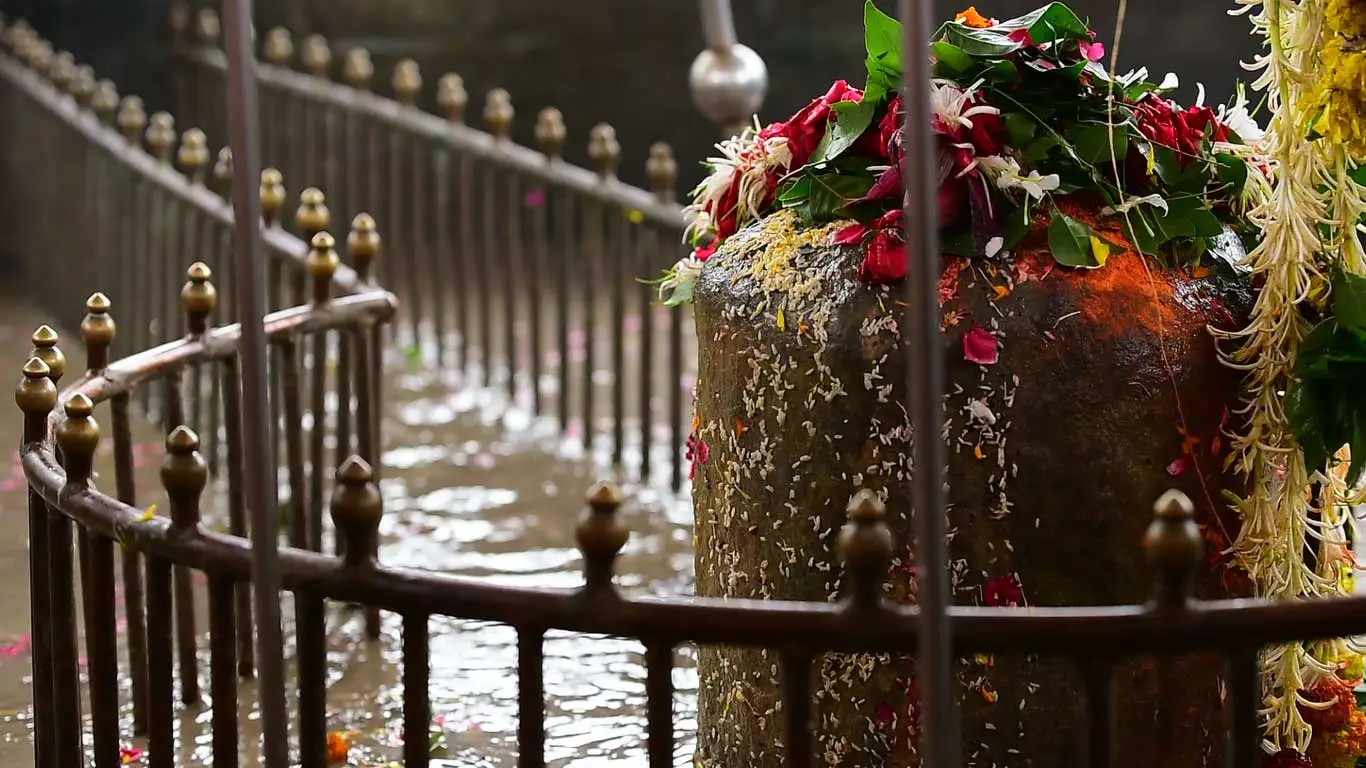
Source: Shree Stambheshwar Mahadev
The Stambheshwar Mahadev Temple’s history is beyond fascinating! In my quest to learn more, I discovered that Lord Shiva is also the presiding deity of the ancient city of Sthaneshwar, now known as Thanesar or Kurukshetra. Legends trace the temple’s origins back to the Mahabharata period. It is said that Lord Krishna, along with the Pandavas, worshipped Lord Shiva here and received his blessings for their impending victory in the great battle of Mahabharata.
A pilgrimage to Kurukshetra is considered incomplete without visiting this sacred site. Historically significant, the founder of the Vardhana Empire, Pushpabhuti, named the capital of his kingdom after Sthaneshwar Shiva, underscoring the deity’s importance.
The present temple structure is attributed to Sadashivrao Bhau, the Commander-in-Chief of the Maratha forces. He is believed to have constructed it to commemorate his victory over Ahmed Shah Abdali at Kunjpura, prior to the third battle of Panipat. This historical connection adds another layer of reverence and significance to the Stambheshwar Mahadev Temple in Kavi Kamboi.
The mystery behind the Stambheshwar Mahadev Temple in Kavi Kamboi disappearance
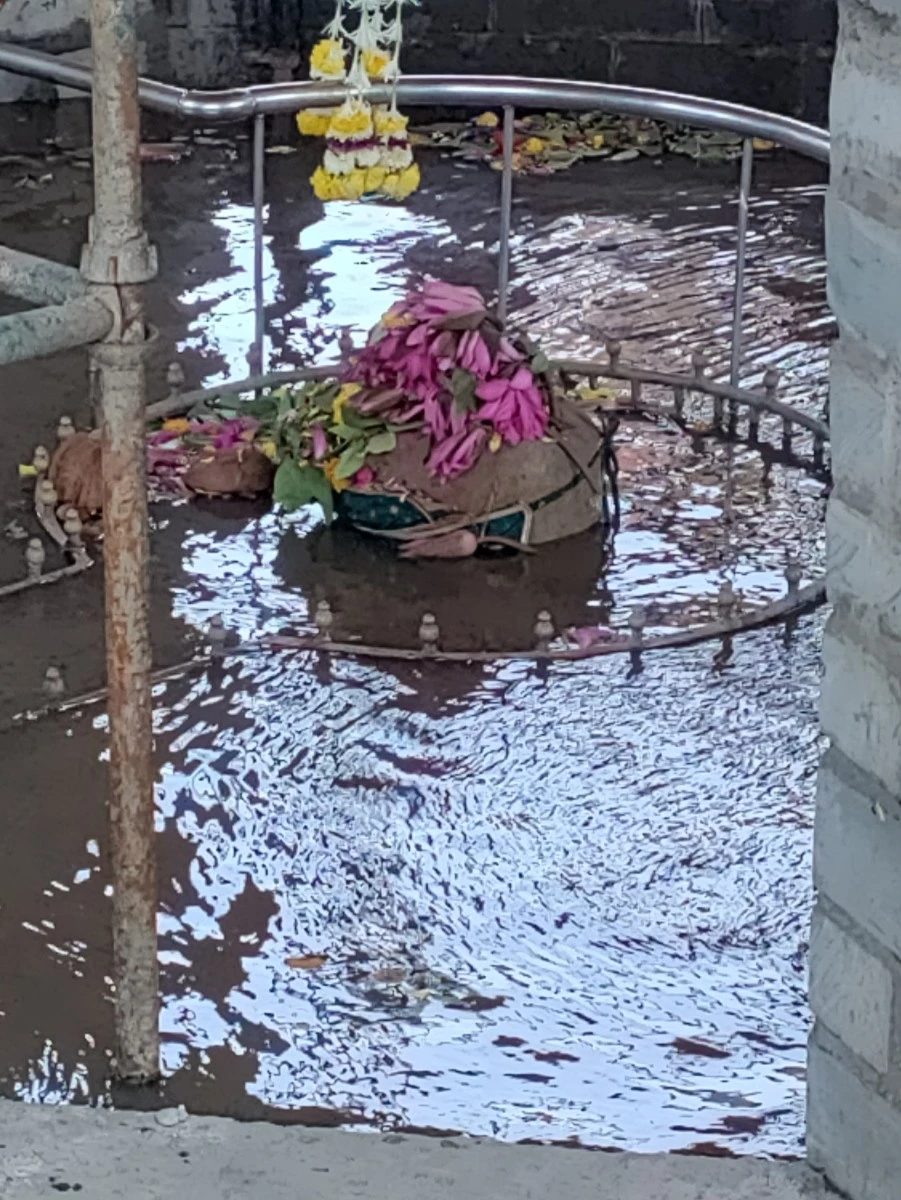
The ‘Gayab Mandir,’ disappears 2 times a day! The Stambheshwar Mahadev Temple in Kavi Kamboi is uniquely situated just a few meters from the seashore. This strategic location causes the temple to submerge during high tide and reappear during low tide. As the sea level rises twice daily, the temple vanishes beneath the waves and reemerges when the waters recede. During high tide, the Garbha Griha, or sanctum sanctorum, is completely covered by sea waters, leaving only the temple’s pinnacle, which was constructed in recent times, visible above the surface.
A fascinating aspect of this phenomenon occurs when the flowers placed on the Shiva lingam by devotees during low tide float to the surface during high tide, creating a colorful spectacle on the seawater. This natural occurrence is perceived as Mother Nature herself performing the ‘Jal Abhishekh’ (water offering) to the holy Shiva lingam.
On our visit, we offered puja at the temple, enjoyed some food, and took a long walk along the beach. We eagerly awaited the high tide, which was expected to start at 6:30 PM. Witnessing the temple’s disappearance was a thrilling experience, as waves suddenly surged and engulfed the structure, illustrating the temple’s mysterious vanishing act. The temple’s transient existence serves as a profound metaphor for the impermanence of life and the eternal cycle of creation and destruction symbolized by Lord Shiva.
Stambheshwar Mahadev Temple in Kavi Kamboi tide timings
The timings for visiting the Stambheshwar Mahadev Temple in Kavi Kamboi vary according to the tidal patterns, as the temple submerges and reappears with the rise and fall of the sea level. The shivlinga is close to 4 feet and it is a sight for everyone to see the seawater gradually making its way towards the shivlinga and the temple during the high tide and submerging them. During the high tide, the seawater rises by close to 12 feet.
It can be said the same when the water starts receding that the shivlinga slowly comes back into view. Anyone who wants to visit this fabulous place should plan the visit so that they can worship the lord before or after the tide. To plan your trip, it is crucial to consult this tide chart, which provides the specific times for high and low tides.
Times of waves/ tides:
| Date | Darshan Time (1st Session) | Darshan Time (2nd Session) |
| Ekam | 9.15 am To 3.45 pm | 9.15 pm To 3.45 am |
| Bij | 10.30 am To 4.30pm | 10.30 pm To 4.30 am |
| Trij | 11.15 am To 5.15 pm | 11.15 pm To 5.15 am |
| Chouth | 12 Noon To 6.00 pm | 12 Midnight To 6.00 am |
| Pancham | Sunrise To 7.00 am | 1.00 pm To 4.00 pm |
| Chath | Sunrise To 7.45 am | 1.15 pm To 7.15 pm |
| Satam | Sunrise To 8.00 am | 2.30 pm To 8.30 pm |
| Aatham | Sunrise To 9.45 am | 3.15 pm To 9.15 pm |
| Naum | Sunrise To 10.00 am | 4.00 pm To 10.00 pm |
| Dasham | Sunrise To 10.45 am | 4.45 pm To 10.45 pm |
| Agiyaras | 5.30 am To 11.30 am | 5.30 pm To 11.30 pm |
| Baras | 6.30 am To 12.30 pm | 6.30 pm To Midnight 00.30 am |
| Teras | 7.15 am To 1.15 pm | 7.15 pm To Midnight 1.15 am |
| Choudash | 8.00 am To 2.00 pm | 8.00 pm To Midnight 2.00 am |
| Poonam – Amavastha | 9.00 am To 3.00 pm | 9.00 pm |
The best time to visit the Stambheshwar Mahadev Temple in Kavi Kamboi is between 2 and 3 p.m. This window is crucial because the high tide starts shortly after this period, making the temple inaccessible. During high tide, the temple gets submerged in the sea, creating a surreal sight but preventing entry. Therefore, arriving between 2 and 3 p.m. allows you to explore the temple before it becomes enveloped by the waters.
How to reach the Stambheshwar Mahadev Temple in Kavi Kamboi
By road
The Narmada River flows through the Narmada district, runs along the border of the Vadodara district, and traverses the Bharuch district before emptying into the sea near the city of Bharuch. Along this route, there are numerous sites to explore, offering various ways to experience the river. Key cities such as Ahmedabad, Bharuch, Rajpipla, Chanod, and Dabhoi are all accessible by road, providing convenient access points for travelers. The most efficient way to reach the Stambheshwar Mahadev Temple in Kavi Kamboi is by booking a cab from Vadodara, ensuring a comfortable and direct journey to this unique destination.
By train
The nearest railway station to the Stambheshwar Mahadev Temple is Bharuch. This well-connected station is served by several major trains, making it a convenient option for travelers coming from different parts of India. Upon reaching Bharuch, visitors can hire a taxi or use local transportation to reach Kavi Kamboi. The journey from Bharuch to the temple is relatively short, making train travel a practical choice for those who prefer this mode of transportation.
By air
The closest airport to the Stambheshwar Mahadev Temple is located in Vadodara. The Vadodara airport, well-connected with flights from major cities, serves as the primary air gateway to the region. After landing at Vadodara airport, you can book an airport taxi to reach the Stambheshwar Mahadev Temple in Kavi Kamboi. The drive from the airport offers a scenic route, providing an opportunity to enjoy the local landscape on the way to the temple.
Other mysterious temples in India
India is known as the land of 64 crore gods and goddesses, with countless shrines of spiritual gurus and holy sites, including the iconic Stambheshwar Mahadev Temple in Kavi Kamboi. Beyond this unique temple, numerous mysterious temples in India stand out for their intriguing traditions, unconventional deities, and ancient origins. Here are a few of these mysterious temples in India:
1. Kamakhya Devi Temple, Assam
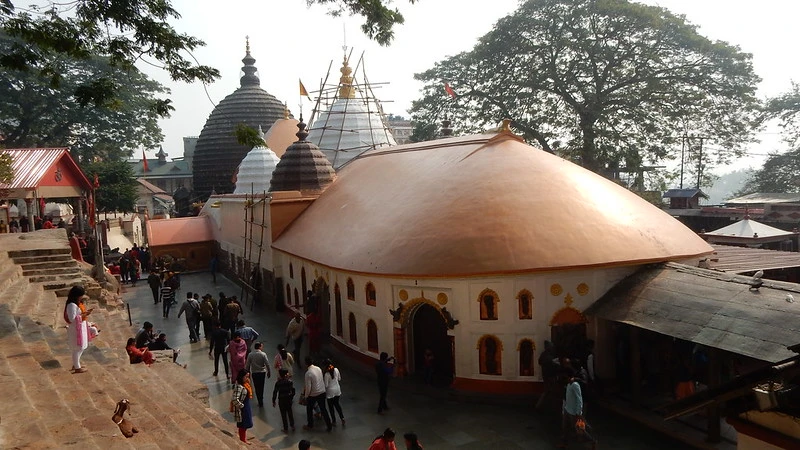
Situated atop Nilachal Hill in Guwahati, the Kamakhya Devi Temple is one of the oldest Shakti Peethas in the Indian subcontinent. Unlike typical temples, it has no deity sculptures; instead, devotees worship the yoni (vagina) of Devi Sati, surrounded by a red silk saree. During the monsoon, the goddess is believed to menstruate, and the temple is closed for three days. The Ambubachi Mela, a tantric fertility festival, marks this period, and an underground spring within the temple is said to turn red. Devotees receive a piece of red cloth as prasad. If you plan to visit this mysterious temple in India, check out this comprehensive Kamakhya Devi Temple travel guide.
2. Mehandipur Balaji Temple, Rajasthan
Located in Rajasthan, Mehandipur Balaji Temple is renowned for exorcism rites. Devotees undergo extreme rituals like hanging from ceilings and self-punishment to rid themselves of evil spirits. This temple, a focal point for expulsion practices by priests, forbids prasad offerings. Visitors are warned not to look back at the temple after leaving to avoid inviting evil spirits.
3. Venkateshwara Temple, Andhra Pradesh
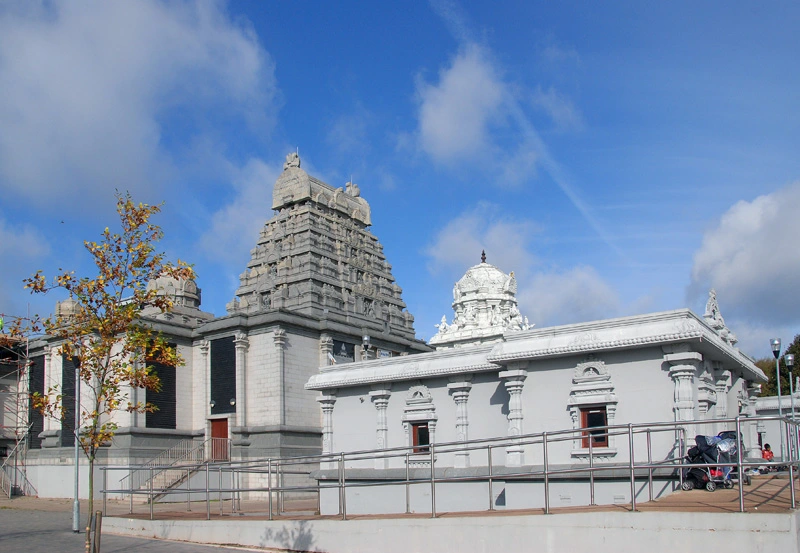
The Sri Venkateswara Swami Temple in Tirupati is famous for its unique tradition of hair sacrifice. Pilgrims donate their hair, which is sold to wig manufacturers globally. Explore the origins of Tirupati’s wig industry, which delves deep into its roots, even as it stands as one of India’s most frequented pilgrimage destinations, providing top-tier wigs to Hollywood’s elite.
4. Kal Bhairav Nath Temple, Varanasi
The Kal Bhairav Nath Temple in Varanasi is an exceptional site where devotees offer alcohol instead of the usual offerings like flowers and sweets. Liquor is poured directly into the mouth of the idol, representing Kal Bhairav, an incarnation of Lord Shiva, and the remainder is given to devotees as prasad. This unique tradition highlights the temple’s distinct practices, setting it apart from other Hindu temples. Numerous shops outside the temple sell various kinds of alcohol to cater to the devotees’ needs. The temple is particularly busy during festivals and attracts many visitors intrigued by its unconventional rituals.
5. Kodungallur Bhagavathy Temple, Kerala
Located in Kerala, the Kodungallur Bhagavathy Temple is dedicated to Goddess Bhadrakali. The temple is best known for the Bharani Festival, a seven-day event during which participants engage in self-inflicted wounds and chant abusive slogans while in a trance-like state. This intense and dramatic celebration includes devotees dressed in red, wielding swords, and exhibiting fervent devotion through these extreme acts. The temple is closed for seven days following the festival to allow for thorough cleaning of the bloodstains left behind.
6. Devji Maharaj Mandir, Madhya Pradesh
The Devji Maharaj Mandir in Madhya Pradesh is a focal point for those seeking exorcism. Every full moon, pilgrims from across India visit to partake in rituals meant to expel evil spirits. Practices include lighting tablets on bare palms and other extreme acts designed to scare away demons. The temple grounds also host the boot mela, or ghost fair, where various rituals are performed to satisfy and drive away negative spirits. This makes Devji Maharaj Mandir one of India’s most mysterious and eerie temples.
7. Devaragattu Temple, Andhra Pradesh
Devaragattu Temple in Andhra Pradesh is renowned for the Bani Festival, held annually during Dussehra. During this festival, participants from Karnataka and Andhra Pradesh gather in large numbers to engage in ritualistic combat, hitting each other with lathis (sticks) until midnight. This 100-year-old tradition was once conducted with axes and spears, making it a dangerous and intense event. The festival is marked by fervent devotion and draws significant crowds, including medical and law enforcement personnel who ensure safety.
8. Jagannath Temple, Odisha
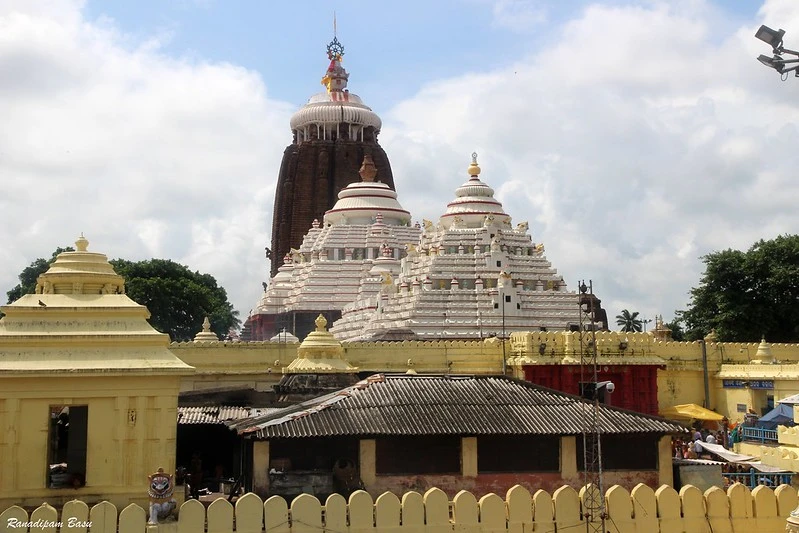
The Jagannath Temple in Puri, Odisha, is famous for its annual Rath Yatra and several mysterious phenomena. One such mystery is the temple’s flag, which flies against the wind’s direction, defying conventional physics. Priests must climb a 20-foot-high structure daily to change the flag, a ritual believed to be crucial for the temple’s functioning. If the ritual is missed, it is said that the temple will remain closed for 18 years. These unique practices contribute to the temple’s mystique and reverence.
9. Nidhivan Temple, Uttar Pradesh
Nidhivan Temple in Uttar Pradesh is deeply associated with Lord Krishna. The temple is surrounded by unique trees with hollow trunks and entwined branches. It is believed that Lord Krishna performs Ras Leela here every night. Devotees and priests leave offerings inside the temple in the evening, and these offerings are found scattered the next morning, indicating divine presence. The area is filled with monkeys during the day, but they mysteriously vacate the premises at dusk, adding to the temple’s enigmatic aura.
10. Padmanabhaswamy Temple, Kerala
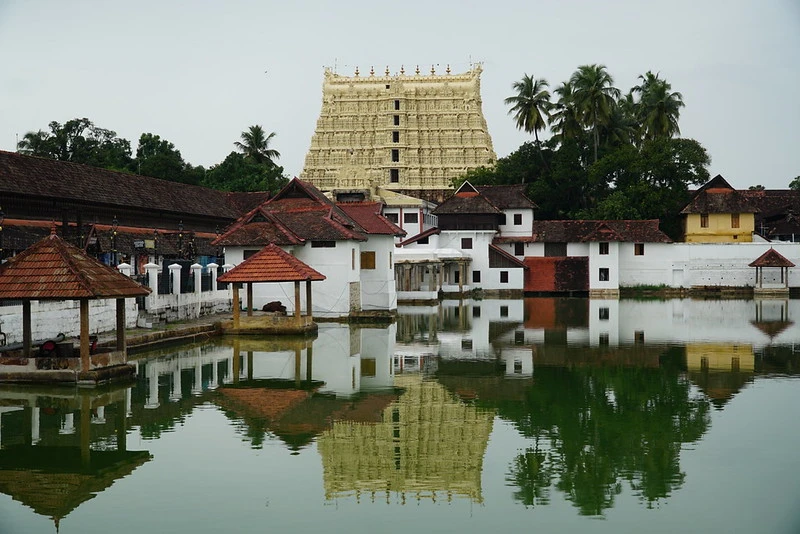
Situated in Thiruvananthapuram, Kerala, the Padmanabhaswamy Temple is known as the world’s richest temple, holding treasures worth billions of dollars. The temple’s vaults contain immense wealth, with the 7th secret chamber believed to hold even more. This chamber remains unopened due to fears that opening it could bring disaster. The Supreme Court of India ordered the opening of six chambers, which revealed a vast collection of gold and precious stones. The unopened 7th chamber adds to the temple’s mystique and allure.
11. Meenakshi Amman Temple, Tamil Nadu
The Meenakshi Amman Temple in Madurai, Tamil Nadu, is both historically and mythologically significant. It is believed to be the site where Lord Shiva as Sundareshwar, married Goddess Meenakshi. This temple is unique as it depicts Lord Shiva with a smiling face, a rare representation. The temple is dedicated to both Lord Shiva and Goddess Parvati, but the primary deity worshipped first is Goddess Meenakshi. The temple’s architectural grandeur and spiritual significance make it a key pilgrimage site. If you plan to visit this mysterious temple in India, check out this comprehensive Meenakshi Amman Temple travel guide.
12. Konark Sun Temple, Odisha
The Konark Sun Temple in Odisha is an architectural marvel with a mysterious past. Being one of the most mysterious temples in India, the temple doors have remained closed for over 118 years. Historically, the temple featured a sun idol that appeared to be suspended in mid-air due to magnetic forces. This unique construction drew immense curiosity and led to various legends. Portuguese sailors, intrigued by the magnetic forces, attempted to dismantle it, causing partial collapse. There are several more mysteries surrounding the Konark Sun Temple that continue to fascinate visitors.
13. Kakanmath Temple, Madhya Pradesh
The Kakanmath Temple in Morena, Madhya Pradesh, is a stunning architectural wonder believed to have been built by ghosts overnight. According to local legend, the temple was constructed in a single night with stones transported from distant places by supernatural forces. This tale has intrigued many, and the temple’s architectural stability adds to its mystery. Despite being centuries old, the temple’s structure remains remarkably well-preserved, attracting curious visitors and historians alike.
14, Chinese Kali Mata Temple, Kolkata
The Chinese Kali Mata Temple in Tangra is a unique blend of cultures, managed by the community of Chinese settlers in Kolkata. This temple stands out not only for its spiritual significance but also for its unconventional offerings. Instead of the typical prasad, devotees receive momos and noodles as prasad, reflecting the harmonious fusion of Indian and Chinese traditions. This fascinating temple attracts many visitors who are intrigued by its distinctive practices and cultural integration. Click here to read more about this fascinating Chinese temple in India.
15. Bhojpur Temple, Madhya Pradesh
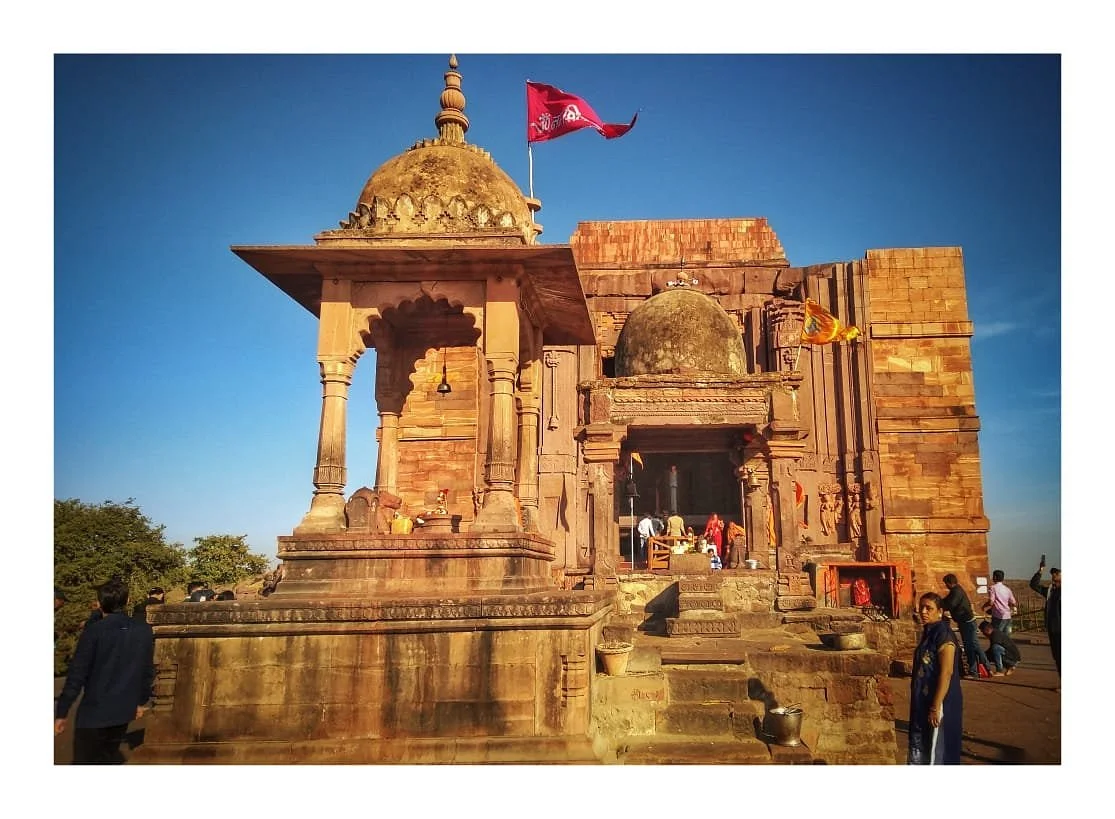
The Bhojpur Temple, according to the Archaeological Survey of India (ASI), houses one of the tallest and grandest Shiva Lingams in India, carved from a single rock. The sheer size and intricacy of the lingam make it a marvel of ancient craftsmanship, particularly considering that the temple remains unfinished to this day. Historians speculate that natural disasters, wars, or a scarcity of resources halted the temple’s construction. In 2006-07, an ASI team led by archaeologist KK Muhammad undertook efforts to conserve the temple. According to their findings, one reason the temple was left unfinished was that the stone roof’s structure couldn’t support its weight, leading to its collapse. The original architectural plans reveal a much larger temple complex envisioned by Raja Bhoj, which was never completed.
16. Bhavani Mata Mandir, Jawai, Rajasthan
In the rugged landscapes of Rajasthan lies the Bhavani Mata Mandir in Jawai, a small village known for its remarkable example of peaceful coexistence between humans and wildlife. The temple stands as a beacon of reverence and tranquility, with an unexpected guest often making an appearance—the elusive leopard. Leopards are frequently seen lounging on the temple steps, symbolizing the unique bond between the villagers and the big cats. This harmonious relationship adds a layer of mystery and intrigue to the Bhavani Mata Mandir, making it one of the most fascinating and mysterious temples in India.
Why visit the Stambheshwar Mahadev Temple in Kavi Kamboi with Savaari?
After exploring the temple, we sat down together for some refreshments from the local vendors and enjoyed the tranquility of the beach. Though there wasn’t much to do around, tea stalls and kiosks were selling delicious snacks like Khichu and Halwa. We noticed locals offering horse-cart rides to tourists, providing a unique way to earn a living. Initially, I was too scared to try a horse ride, but my cousins convinced me, and it turned out to be a memorable experience.
After our adventure, we headed back home in the comfort of our Savaari cab. I was highly impressed by the convenience and comfort it provided. Our chauffeur was incredibly knowledgeable about the area and its history, enhancing our visit with fascinating insights. I highly recommend downloading the Savaari car rental app for a seamless and enriching trip to see the disappearing temple. It’s an experience you won’t want to miss!
Last Updated on August 19, 2024 by Shabari Shankar
